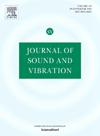Acoustic-modeling of random fibrous materials
IF 4.3
2区 工程技术
Q1 ACOUSTICS
引用次数: 0
Abstract
We present a microstructure-based model for determining the sound absorption behavior and transport parameters of random fibrous materials and exploring the physical mechanisms underlying acoustic energy dissipation. In order to increase the generalizability of the model, a three-dimensional random fiber structure is employed for simulation. The propagation of sound waves is associated with four transport parameters, including viscous permeability, tortuosity, as well as viscous and thermal characteristic lengths. These parameters are determined by the porosity and diameter of the fibrous material. By using the method of multi-scale asymptotic simulation, the theoretical model for transport parameters includes unknown coefficients that are adjusted based on the simulated results. The sound absorption coefficients are then obtained by integrating the transport parameters into the widely-used Johnson-Champoux-Allard (JCA) model for porous materials. The theoretical predictions match well with existing experimental measurements on sintered fiber metals and fibrous copper wires. Our model systematically examines the impact of fiber diameter, porosity, and material thickness on sound absorption performance. Optimal results are achieved by carefully selecting fiber diameter and porosity to enhance the acoustic dissipation of sound waves, while thicker fibrous materials increase sound absorption in the low frequency range. The model provides a theoretical framework for designing and fabricating fibrous materials to reduce noise.
求助全文
约1分钟内获得全文
求助全文
来源期刊

Journal of Sound and Vibration
工程技术-工程:机械
CiteScore
9.10
自引率
10.60%
发文量
551
审稿时长
69 days
期刊介绍:
The Journal of Sound and Vibration (JSV) is an independent journal devoted to the prompt publication of original papers, both theoretical and experimental, that provide new information on any aspect of sound or vibration. There is an emphasis on fundamental work that has potential for practical application.
JSV was founded and operates on the premise that the subject of sound and vibration requires a journal that publishes papers of a high technical standard across the various subdisciplines, thus facilitating awareness of techniques and discoveries in one area that may be applicable in others.
 求助内容:
求助内容: 应助结果提醒方式:
应助结果提醒方式:


